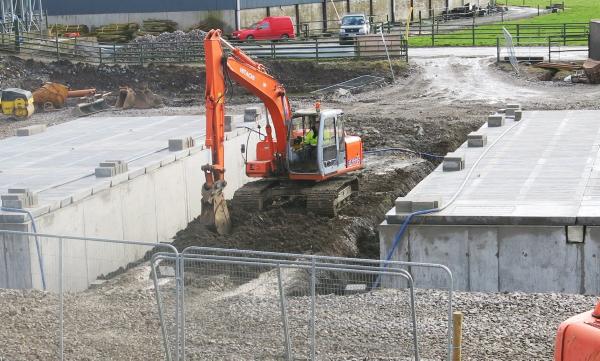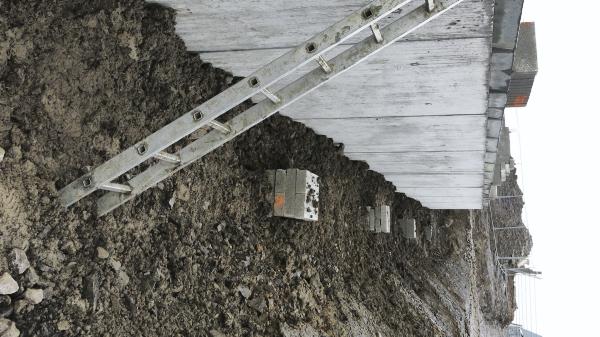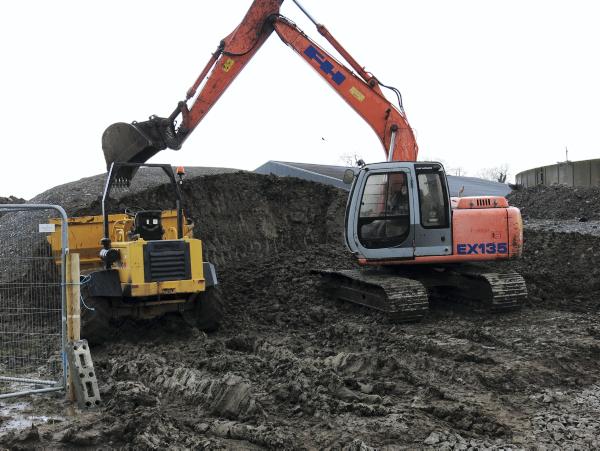At this time of year, excavation work is carried out on many farms for new slatted tanks. A while back, I wrote about new equipment acquired by Co Meath contractor King Concreting to help ensure proper compaction of back-filling around new tanks. This provides solid foundation for feed passages and shed floors.
A number of readers contacted me and reported cracking of concrete in feed passages, which they suspected was caused by inadequate compaction of back-fill material.
Last week, I touched on the issue with Dessie Donohoe of Performance Steel. He visits a lot of sheds to advise on fitting out with barriers, gates, etc, and to measure for same.
Dessie told me he regularly comes across sheds with problems arising from poor back-filling and foundation. He sees shed pillars which have leaned sideways and no longer stand vertically.
In older sheds, he sees cracking of concrete in feed passages and lie-back areas. In both cases, the problem is poor foundation.
Roof pillars
Pillars carry the weight of the shed roof. In a bedded shed or grain store, etc, where no deep excavation is made for a tank, the pillars can sit securely on a relatively shallow foundation.
However, many slatted sheds have pillars standing just outside the tank walls – where the tank excavation took place. The excavation for a tank can extend by 4m outside the four tank walls, depending on ground type.
Pillars in this situation require a support column extending down through the back-fill to the undisturbed ground at the floor of the excavation.
This support column can be made by shuttering a concrete column up from the floor of the excavation. Some building contractors fill circular pipes with concrete or bring up a column of concrete blocks as the support column. The back-fill material is then built up and compacted around the columns and the shed pillars eventually secured on top.
The various floor slabs around an underground tank likewise sit on back-filled ground. This includes central and outside feed passages where tractors, loaders and feed wagons will be driving when it’s all complete.
It can include lie-back pens where a tractor or loader may drive in to clean out dirty bedding.
It may include cubicle areas running alongside slatted tanks, although these tend not to carry heavy traffic.
All these floor slabs depend on the back-fill being properly compacted to provide a good foundation.
Off-square
“In our work, we often see pillars for shed roofs that have sunk,” said Dessie Donohoe.
“They are off-square, to the left or right. We see it when we drive into the yard – the roof is off. With pillars, you are supposed to bring up a concrete support from undisturbed ground at the bottom of the excavation. The best system is to shutter it, using circular or square shutters, if you have the shutters.
“We also see cracks in passages and floors. A lot of contractors back-fill too soon and don’t tamp it down well enough. Two years later, the ground has subsided. Often, it’s when a farmer adds an extra bay onto a shed that he sees under the concrete slab and realises there has been subsidence.”
Dessie has some useful tips for farmers:
Tank excavations need to be dug early in the year, well before winter housing, and the tank given 28 days to cure. Then the contractor can do a decent back-fill, tamping it down well without worrying about the walls. You must use decent material for back-filling. The subsoil that was dug out is usually good enough – once is hasn’t got too wet. Topsoil has to be kept separate as it’s too soft.You must sort out these issues in advance with the contractor. Ask if girders will be cased or supported all the way down to undisturbed ground. Will backfill be bought in or will the spoils be used? If conditions are wet, spoils can go to slop and be no use for back-fill. It is best to agree a price for both outcomes. What happens if you hit a spring when digging out? It should either be drained if that’s possible or back-filled with broken rock. That way you won’t block it and wet the land.
At this time of year, excavation work is carried out on many farms for new slatted tanks. A while back, I wrote about new equipment acquired by Co Meath contractor King Concreting to help ensure proper compaction of back-filling around new tanks. This provides solid foundation for feed passages and shed floors.
A number of readers contacted me and reported cracking of concrete in feed passages, which they suspected was caused by inadequate compaction of back-fill material.
Last week, I touched on the issue with Dessie Donohoe of Performance Steel. He visits a lot of sheds to advise on fitting out with barriers, gates, etc, and to measure for same.
Dessie told me he regularly comes across sheds with problems arising from poor back-filling and foundation. He sees shed pillars which have leaned sideways and no longer stand vertically.
In older sheds, he sees cracking of concrete in feed passages and lie-back areas. In both cases, the problem is poor foundation.
Roof pillars
Pillars carry the weight of the shed roof. In a bedded shed or grain store, etc, where no deep excavation is made for a tank, the pillars can sit securely on a relatively shallow foundation.
However, many slatted sheds have pillars standing just outside the tank walls – where the tank excavation took place. The excavation for a tank can extend by 4m outside the four tank walls, depending on ground type.
Pillars in this situation require a support column extending down through the back-fill to the undisturbed ground at the floor of the excavation.
This support column can be made by shuttering a concrete column up from the floor of the excavation. Some building contractors fill circular pipes with concrete or bring up a column of concrete blocks as the support column. The back-fill material is then built up and compacted around the columns and the shed pillars eventually secured on top.
The various floor slabs around an underground tank likewise sit on back-filled ground. This includes central and outside feed passages where tractors, loaders and feed wagons will be driving when it’s all complete.
It can include lie-back pens where a tractor or loader may drive in to clean out dirty bedding.
It may include cubicle areas running alongside slatted tanks, although these tend not to carry heavy traffic.
All these floor slabs depend on the back-fill being properly compacted to provide a good foundation.
Off-square
“In our work, we often see pillars for shed roofs that have sunk,” said Dessie Donohoe.
“They are off-square, to the left or right. We see it when we drive into the yard – the roof is off. With pillars, you are supposed to bring up a concrete support from undisturbed ground at the bottom of the excavation. The best system is to shutter it, using circular or square shutters, if you have the shutters.
“We also see cracks in passages and floors. A lot of contractors back-fill too soon and don’t tamp it down well enough. Two years later, the ground has subsided. Often, it’s when a farmer adds an extra bay onto a shed that he sees under the concrete slab and realises there has been subsidence.”
Dessie has some useful tips for farmers:
Tank excavations need to be dug early in the year, well before winter housing, and the tank given 28 days to cure. Then the contractor can do a decent back-fill, tamping it down well without worrying about the walls. You must use decent material for back-filling. The subsoil that was dug out is usually good enough – once is hasn’t got too wet. Topsoil has to be kept separate as it’s too soft.You must sort out these issues in advance with the contractor. Ask if girders will be cased or supported all the way down to undisturbed ground. Will backfill be bought in or will the spoils be used? If conditions are wet, spoils can go to slop and be no use for back-fill. It is best to agree a price for both outcomes. What happens if you hit a spring when digging out? It should either be drained if that’s possible or back-filled with broken rock. That way you won’t block it and wet the land. 





 This is a subscriber-only article
This is a subscriber-only article












SHARING OPTIONS: